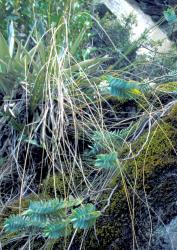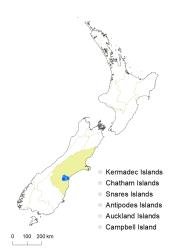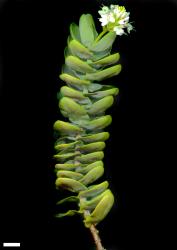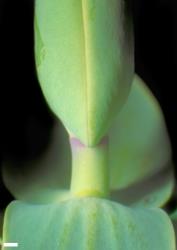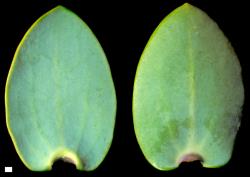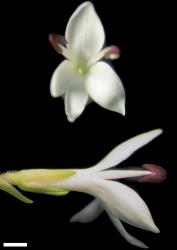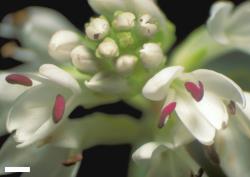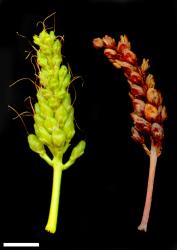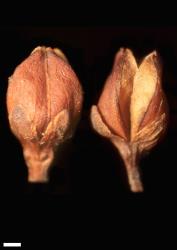- Taxon
- Gallery
- ≡ Hebe pareora Garn.-Jones & Molloy, New Zealand J. Bot. 20: 398 (1983)
Few-branched shrub to 0.5 m tall, but trailing branches up to 3 m long. Stems trailing, erect at apex and when young, glabrous. Leaf bud distinct, its leaves appressed until fully grown; sinus absent. Leaves opposite-decussate, erecto-patent to reflexed; lamina coriaceous, ovate, elliptic, oblong, or obovate, 15–30 mm long, 10–18 mm wide, dull and glaucous above and beneath; midrib and 2–4 lateral veins evident especially when dry; surfaces glabrous; margins glabrous, entire; apex sub-acute to rounded; base sub-cordate and amplexicaul; petiole absent. Inflorescence a lateral raceme, 30–70 mm long; flowers crowded, 12–60, all bisexual; bracts alternate, sometimes the lowest in a whorl of 3, linear to narrowly deltoid, about = or > pedicels; pedicels erecto-patent to spreading, 1.0–4.5 mm long, glabrous or very sparsely eglandular-hairy all around. Calyx lobes 4, sub-acute to acute, 2.0–2.5 mm long, sub-equal, glabrous or very sparsely eglandular-ciliate. Corolla 8–10 mm diameter; tube white, 3–4 mm long, > calyx, glabrous; lobes 4, white, erecto-patent to spreading, unequal, elliptic to lanceolate, 4–5 mm long, acute to rounded; nectar guides absent. Stamen filaments white, 4.0–5.5 mm long; anthers magenta. Style glabrous, 6.7–10.0 mm long. Capsules broadly angustiseptate to narrowly latiseptate, emarginate to didymous, glabrous, 3–5 mm long, 2.5–3.5 mm at widest point. Seeds ellipsoid to obovoid, weakly flattened, smooth, straw-yellow to pale brown, 1.3–1.5 mm long.
Most of the hebes with glaucous leaves have smaller leaves than V. pareora. V. pareora stems often hang down from riverside rocks and cliffs and are long and leafless with a cluster of leaves near the apex.
Plants of V. albicans from Nelson can approach similar leaf sizes, but their stems are weakly hairy, leaves at most weakly amplexicaul, corolla lobes smaller and rounder, and capsules latiseptate.
V. amplexicaulis plants are found in South Canterbury, near to V. pareora. They have similar amplexicaul leaves, but differ in their usually hairy stems (occasionally glabrous or sometimes just a few hairs near leaf bases), leaves usually red at the margins, smaller, and without evident veins, inflorescences shorter with densely hairy peduncles, flowers sessile, bracts about equalling the calyx, smaller and narrower corolla lobes, and capsules that are more strongly latiseptate and often hairy.
V. pinguifolia plants also have glaucous leaves, but these are not amplexicaul; they also differ in their bifarious stem hairs, sessile flowers, and latiseptate hairy capsules.
South Island: Canterbury (north-eastern slope of the Hunter’s Hills: Rocky Gully, upper Pareora River, White Rock River, Nimrod Stream). There are unvouchered records from Ōpihi Gorge and Blue Duck Stream.
Rock outcrops and cliffs in river and stream gorges. Recorded elevations range from 360 to 761 m.
Flowers: November–January; fruits: January–February (persisting longer).
2n = 40 (see Bayly & Kellow 2006, as Hebe pareora).
Veronica pareora is classified in V. subg. Pseudoveronica sect. Hebe and the informal group “Subcarnosae” (Albach & Meudt 2010; Bayly & Kellow 2006). V. pareora shares amplexicaul glaucous leaves with V. amplexicaulis , which grows nearby and might be related to it. DNA sequence data do not refute that suggestion, but a close relationship has not been demonstrated.



